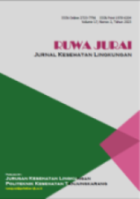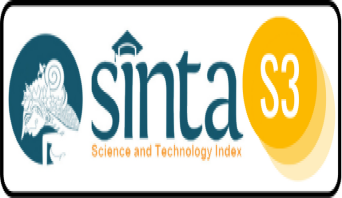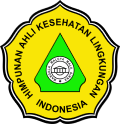Determining Stunting Risk Areas Using a Combined AHP-GIS approach: A Case Study of Pesawaran Regency, Lampung, Indonesia
DOI:
https://doi.org/10.26630/rj.v19i1.5046Keywords:
Stunting, GIS, AHP, Environment, HealthAbstract
Considering the highly detrimental future impacts of stunting, a risk map is needed. It will serve as a basis to design stunting control strategies. This study aims to determine stunting risk areas by combining the Analytical Hierarchy Process (AHP) and Geographic Information System (GIS). This study used ecological design, with a case being studied was Pesawaran Regency, Lampung Province. All secondary data were aggregate, and used sub-districts as spatial boundaries. Study variables comprised access to safe drinking water, healthy sanitation, exclusive breastfeeding, complete immunization, diarrhea, number of health facilities, fourth visit during pregnancy (ANC-K4), and child growth and development monitoring. The map was developed by employing Weighted Sum Overlay (WSO) technique. Determining weights involving multiple criteria was conducted by using AHP. The AHP yielded weighted values for each variable, namely exclusive breastfeeding (22.9%), ANC-K4 (14.4%), monitoring of child growth and development (11.7%), access to safe drinking water (11.0%), diarrhea (10.8%), number of health facilities (10.1%), complete basic immunization (10.1%), and healthy sanitation (9.0%). WSO technique revealed that three out of eleven sub-districts were included in the high-risk category for stunting (Tegineneng, Kedondong, and Padang Cermin). Meanwhile, the remaining areas were included in the medium category (Way Khilau, Marga Punduh, and Punduh Pedada) and low category (Negara Katon, Gedong Tataan, Way Lima, Way Ratai, and Teluk Pandan). GIS and AHP methods were applied to determine stunting risk areas. Areas with a high risk of stunting category are Tegineneng, Kedondong, and Padang Cermin. Suggested fundamental programs to control stunting are improvement in exclusive breastfeeding, ANC-K4 visit, monitoring of children growth and development, access to drinking water, and prevention of diarrhea.
References
Adedeji, I., John, C., Okolo, S., Ebonyi, A., Abdu, H., & Bashir, M. (2017). Malnutrition and the Intelligence Quotient of Primary School Pupils in Jos, Nigeria. British Journal of Medicine and Medical Research, 21(2), 1–13. https://doi.org/https://doi.org/10.9734/BJMMR/2017/32504
Anwar, C., Abdullah, M., & Sasmita, V. (2020). Stunting dan Faktor yang Berhubungan Studi Kasus Kontrol di Wilayah Kerja Puskesmas Baitussalam Kabupaten Aceh Besar. Journal of Healthcare Technology and Medicine, 6(2), 988. https://doi.org/10.33143/jhtm.v6i2.1085
Aykut, T. (2021). Determination of groundwater potential zones using Geographical Information Systems (GIS) and Analytic Hierarchy Process (AHP) between Edirne-Kalkansogut (northwestern Turkey). Groundwater for Sustainable Development, 12, 100545. https://doi.org/10.1016/j.gsd.2021.100545
Baite, L., Bhattacharjee, N., Debbarma, J., & Saikia, A. (2024). Agricultural land suitability analysis in Manipur, India using GIS and AHP. AUC Geographica, 59(1), 93–107. https://doi.org/10.14712/23361980.2024.6
Basharat, M., Shah, H. R., & Hameed, N. (2016). Landslide susceptibility mapping using GIS and weighted overlay method: a case study from NW Himalayas, Pakistan. Arabian Journal of Geosciences, 9(4), 292. https://doi.org/10.1007/s12517-016-2308-y
Development Initiatives Poverty Research. (2018). Global Nutrition Report- Shining a Light to Spur Action on Nutrition. In Development Initiatives Poverty Research.
Díaz-Alcaide, S., & Martínez-Santos, P. (2019). Review: Advances in groundwater potential mapping. Hydrogeology Journal, 27(7), 2307–2324. https://doi.org/10.1007/s10040-019-02001-3
Ding, Z., Zhu, M., Wu, Z., Fu, Y., & Liu, X. (2018). Combining AHP-Entropy Approach with GIS for Construction Waste Landfill Selection—A Case Study of Shenzhen. International Journal of Environmental Research and Public Health, 15(10), 2254. https://doi.org/10.3390/ijerph15102254
Eryando, T., Sipahutar, T., Budhiharsana, M. P., Siregar, K. N., Nur Aidi, M., Minarto, Utari, D. M., Rahmaniati, M., & Hendarwan, H. (2022). Spatial analysis of stunting determinants in 514 Indonesian districts/cities: Implications for intervention and setting of priority. Geospatial Health, 17(1). https://doi.org/10.4081/gh.2022.1055
Fotheringham, A. S., & Rogerson, P. A. (2008). The SAGE Handbook of Spatial Analysis. SAGE Publications.
He, P., Liu, L., Salas, J. M. I., Guo, C., Cheng, Y., Chen, G., & Zheng, X. (2018). Prenatal malnutrition and adult cognitive impairment: a natural experiment from the 1959–1961 Chinese famine. British Journal of Nutrition, 120(2), 198–203. https://doi.org/10.1017/S0007114518000958
Hidayah, N., Rita, W., Anita, B., Podesta, F., Ardiansyah, S., Subeqi, A. T., Nasution, S. L., & Riastuti, F. (2019). Hubungan pola asuh dengan kejadian stunting (rekomendasi pengendaliannya di Kabupaten Lebong). Riset Informasi Kesehatan, 8(2), 140. https://doi.org/10.30644/rik.v8i2.237
Indah Nurdin, S. S., Octaviani Katili, D. N., & Ahmad, Z. F. (2019). Faktor ibu, pola asuh anak, dan MPASI terhadap kejadian stunting di kabupaten Gorontalo. Jurnal Riset Kebidanan Indonesia, 3(2), 74–81. https://doi.org/10.32536/jrki.v3i2.57
Indonesian Government. (2021). Peraturan Presiden Nomor 72 Tahun 2021 Tentang Percepatan Penurunan Stunting. In Indonesian Government (Issue 1, p. 23).
Leroy, J. L., & Frongillo, E. A. (2019). Perspective: What Does Stunting Really Mean? A Critical Review of the Evidence. Advances in Nutrition, 10(2), 196–204. https://doi.org/10.1093/advances/nmy101
Ministry of Health Republic Indonesia. (2022a). Buku Saku Hasil Survei Status Gizi Indonesia (SSGI) 2022 (pp. 1–154). Badan Kebijakan Pembangunan Kesehatan Kementerian Kesehatan RI.
Ministry of Health Republic Indonesia. (2022b). Peraturan Menteri Kesehatan RI Nomor 13 Tahun 2022 Tentang Perubahan Atas Peraturan Menteri Kesehatan Nomor 21 Tahun 2020 Tentang Rencana Strategis Kementerian Kesehatan Tahun 2020-2024 (pp. 1–592). Kementerian Kesehatan Republik Indonesia.
Ministry of the State Secretariat. (2021). Strategi Nasional Stunting. Ministry of the State Secretariat.
Niga, D. M., & Purnomo, W. (2016). Hubungan Antara Praktik Pemberian Makan, Perawatan Kesehatan, dan Kebersihan Anak Dengan Kejadian Stunting Pada Anak Usia 1-2 Tahun di Wilayah Kerja Puskesmas Oebobo Kota Kupang. Wijaya, 3(2), 151–155.
Nugroho, A. (2016). Determinan Growth Failure (Stunting) pada Anak Umur 1 S/D 3 Tahun (Studi di Kecamatan Tanjungkarang Barat Kota Bandar Lampung). Jurnal Kesehatan, 7(3), 470. https://doi.org/10.26630/jk.v7i3.231
Pfeiffer, D. U., Robinson, T. P., Stevens, K. B., Rogers, D. J., & Clements, A. C. A. (2008). Spatial Analysis in Epidemiology. In Oxford University Press. Oxford University Press.
Rahman, F. D. (2018). The Effect of Feeding Patterns on the Incidence of Stunting in Toddlers. The Indonesian Journal of Health Science, 10(1), 15–24. https://doi.org/10.32528/the.v10i1.1451
Saaty, R. W. (1987). The analytic hierarchy process—what it is and how it is used. Mathematical Modelling, 9(3–5), 161–176. https://doi.org/10.1016/0270-0255(87)90473-8
Saaty, T. L. (2008). Decision making with the analytic hierarchy process. Int. J. Services Sciences, 1(1), 83–98. https://doi.org/10.1504/IJSSCI.2008.017590
Sahin, F., Kara, M. K., Koc, A., & Sahin, G. (2020). Multi-criteria decision-making using GIS-AHP for air pollution problem in Igdir Province/Turkey. Environmental Science and Pollution Research, 27(29), 36215–36230. https://doi.org/10.1007/s11356-020-09710-3
Semba, R. D., de Pee, S., Sun, K., Sari, M., Akhter, N., & Bloem, M. W. (2008). Effect of parental formal education on risk of child stunting in Indonesia and Bangladesh: a cross-sectional study. The Lancet, 371(9609), 322–328. https://doi.org/10.1016/S0140-6736(08)60169-5
Souris, M. (2019). Epidemiology and Geography. Wiley. https://doi.org/10.1002/9781119528203
WHO. (2023). Level and trend in child malnutrition. In World Health Organization.
Widyaningsih, N. N., Kusnandar, K., & Anantanyu, S. (2018). Keragaman pangan, pola asuh makan dan kejadian stunting pada balita usia 24-59 bulan. Jurnal Gizi Indonesia (The Indonesian Journal of Nutrition), 7(1), 22–29. https://doi.org/10.14710/jgi.7.1.22-29
World Health Organization. (2013). Childhood Stunting : Context , Causes and Consequences WHO Conceptual framework.
Yushananta, P., & Ahyanti, M. (2022). Risk Factors of Stunting in ChildrenAged 6–59 Months: A Case-Control Study in Horticulture Area. Open Access Macedonian Journal of Medical Sciences, 10(E), 1–5. https://doi.org/10.3889/oamjms.2022.7768
Yushananta, P., & Ahyanti, M. (2024). Risk of Prenatal Pesticide Exposure to Anemia and Stunted Birth in Horticultural Areas of West Lampung Regency, Indonesia. International Journal of Occupational Safety and Health, 14(4), 457–466. https://doi.org/10.3126/ijosh.v14i4.56100
Yushananta, P., Muslim, A., & Rusli, Y. (2023). Specific Determinants of Stunting Toddlers in Lampung Province: Spatial Data Analysis. Jurnal Kesehatan, 14(3), 462–474. https://doi.org/10.26630/jk.v14i3.4182
Zabihi, H., Alizadeh, M., Kibet Langat, P., Karami, M., Shahabi, H., Ahmad, A., Nor Said, M., & Lee, S. (2019). GIS Multi-Criteria Analysis by Ordered Weighted Averaging (OWA): Toward an Integrated Citrus Management Strategy. Sustainability, 11(4), 1009. https://doi.org/10.3390/su11041009
Downloads
Published
How to Cite
Issue
Section
License
Copyright (c) 2025 Ruwa Jurai: Jurnal Kesehatan Lingkungan

This work is licensed under a Creative Commons Attribution-NonCommercial 4.0 International License.

Ruwa Jurai: Jurnal Kesehatan Lingkungan is licensed under a Creative Commons Attribution-NonCommercial 4.0 International License.
Authors who publish with this journal agree to the following terms:
- Authors retain copyright and grant the journal right of first publication with the work simultaneously licensed under a Creative Commons Attribution-Non Commercial License that allows others to share the work with an acknowledgment of the work's authorship and initial publication in this journal.
- Authors are able to enter into separate, additional contractual arrangements for the non-exclusive distribution of the journal's published version of the work (e.g., post it to an institutional repository or publish it in a book), with an acknowledgment of its initial publication in this journal.
- Authors are permitted and encouraged to post their work online (e.g., in institutional repositories or on their website) prior to and during the submission process, as it can lead to productive exchanges, as well as earlier and greater citation of published work.









